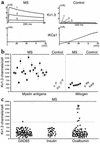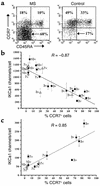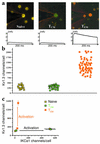The voltage-gated Kv1.3 K(+) channel in effector memory T cells as new target for MS
- PMID: 12782673
- PMCID: PMC156104
- DOI: 10.1172/JCI16921
The voltage-gated Kv1.3 K(+) channel in effector memory T cells as new target for MS
Erratum in
- J Clin Invest. 2003 Jul;112(2):298
Abstract
Through a combination of fluorescence microscopy and patch-clamp analysis we have identified a striking alteration in K(+) channel expression in terminally differentiated human CCR7(-)CD45RA(-) effector memory T lymphocytes (T(EM)). Following activation, T(EM) cells expressed significantly higher levels of the voltage-gated K(+) channel Kv1.3 and lower levels of the calcium-activated K(+) channel IKCa1 than naive and central memory T cells (T(CM)). Upon repeated in vitro antigenic stimulation, naive cells differentiated into Kv1.3(high)IKCa1(low) T(EM) cells, and the potent Kv1.3-blocking sea anemone Stichodactyla helianthus peptide (ShK) suppressed proliferation of T(EM) cells without affecting naive or T(CM) lymphocytes. Thus, the Kv1.3(high)IKCa1(low) phenotype is a functional marker of activated T(EM) lymphocytes. Activated myelin-reactive T cells from patients with MS exhibited the Kv1.3(high)IKCa1(low) T(EM) phenotype, suggesting that they have undergone repeated stimulation during the course of disease; these cells may contribute to disease pathogenesis due to their ability to home to inflamed tissues and exhibit immediate effector function. The Kv1.3(high)IKCa1(low) phenotype was not seen in glutamic acid decarboxylase, insulin-peptide or ovalbumin-specific and mitogen-activated T cells from MS patients, or in myelin-specific T cells from healthy controls. Selective targeting of Kv1.3 in T(EM) cells may therefore hold therapeutic promise for MS and other T cell-mediated autoimmune diseases.
Figures






References
-
- Allegretta M, Nicklas JA, Sriram S, Albertini RJ. T cells responsive to myelin basic protein in patients with multiple sclerosis. Science. 1990;247:718–721. - PubMed
-
- Scholz C, Anderson DE, Freeman GJ, Hafler DA. Expansion of autoreactive T cells in multiple sclerosis is independent of exogenous B7 costimulation. J. Immunol. 1998;160:1532–1538. - PubMed
Publication types
MeSH terms
Substances
Grants and funding
LinkOut - more resources
Full Text Sources
Other Literature Sources
Medical
Molecular Biology Databases

